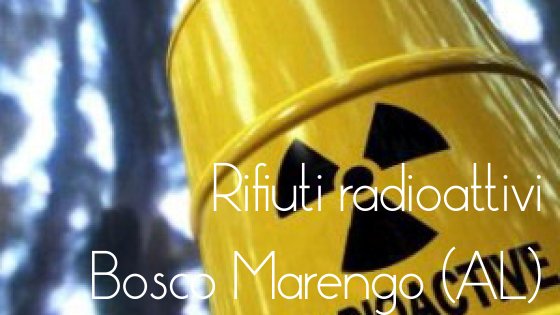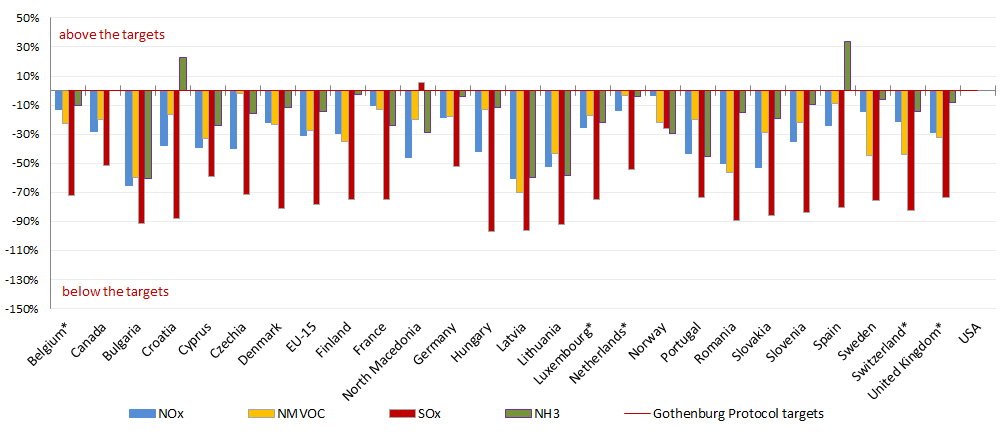Decreto dirigenziale del 23 dicembre 2016

Decreto dirigenziale del 23 dicembre 2016
Decreto di autorizzazione alla modifica della localizzazione delle attività di trattamento e condizionamento dei rifiuti radioattivi dell’impianto di fabbricaz...
1999 Gothenburg Protocol under the LRTAP Convention / Download
- Council decision of 13 june 2003 (OJ L 179, 17.7.2003)
- Decisione el Consiglio del 13 giugno 2003 (GU L 179, 17.7.2003)
The Executive Body adopted the Gothenburg Protocol (GP) on 30 November 1999. The Protocol entered into force on 17 May 2005. Download Status of ratification
The objective of the 1999 Protocol was to control and reduce emissions of sulphur, nitrogen oxides, ammonia and volatile organic compounds that are caused by anthropogenic activities and are likely to cause adverse effects on human health, natural ecosystems, materials and crops, due to acidification, eutrophication or ground-level ozone as a result of long-range transboundary atmospheric transport.
Once the Protocol is fully implemented, Europe’s sulphur emissions should be cut by at least 63%, its NOx emissions by 41%, its VOC emissions by 40% and its ammonia emissions by 17% compared to 1990.
Each Party having an emission ceiling in any table in annex II of GP shall reduce and maintain the reduction in its annual emissions in accordance with that ceiling and the timescales specified in that annex. Each Party shall, as a minimum, control its annual emissions of polluting compounds in accordance with the obligations in annex II.
The figure below includes Parties that ratified the Gothenburg Protocol. Approved adjustments are considered for Denmark (NMVOC, NH3), Finland (NH3), Germany (NOx, NMVOC, NH3), Luxembourg (NOx, NMVOC) and the Netherlands (NMVOC) (Status as of 1 June 2021).
Una volta che il protocollo sarà pienamente attuato, le emissioni di zolfo dell'Europa dovrebbero essere ridotte almeno del 63%, le sue emissioni di NOx del 41%, le sue emissioni di COV del 40% e le sue emissioni di ammoniaca del 17% rispetto al 1990.
Ciascuna Parte che ha un limite di emissione in qualsiasi tabella dell'allegato II del GP deve ridurre e mantenere la riduzione delle proprie emissioni annue conformemente a tale limite e alle scadenze specificate in tale allegato. Ciascuna Parte controlla come minimo le proprie emissioni annue di composti inquinanti conformemente agli obblighi di cui all'allegato II.
La figura seguente include le parti che hanno ratificato il protocollo di Göteborg. Gli adeguamenti approvati sono presi in considerazione per Danimarca (NMVOC, NH 3), Finlandia (NH 3), Germania (NOx, NMVOC, NH 3), Lussemburgo (NOx, NMVOC) e Paesi Bassi (NMVOC) (Stato 1 giugno 2021).

Distance to 1999 GP targets in 2019 (emissions as reported 2021)
The original Gothenburg Protocol to the Convention on Long-range Transboundary Air Pollution (Air Convention) sets emission ceilings (UNECE, 1999) for 2010 and beyond, for the pollutants nitrogen oxides (NOX), non-methane volatile organic compounds (NMVOCs), sulphur oxides (SOX) and ammonia (NH3). In addition to the ceilings for individual countries, the protocol specifies ceilings for the EU, which is a Party to the protocol in its own right (UNECE, 1999). The protocol was amended in 2012, establishing new emission reduction commitments as from 2020 and beyond in terms of percentage reductions relative, to the base year 2005, for the same pollutants and PM2.5. The EU ratified the amended protocol in 2017. Though the emission reduction commitments for 2020 and beyond apply to those Parties that have ratified the amended protocol, the ceilings set for 2010 and the years thereafter are still in place, as there are still Parties to the original protocol that are not yet Parties to the amended version. The emission inventory data and the informative inventory report submitted in 2022 therefore address both the obligations under the emission reduction commitments and those under the emission ceilings.
_______
Guidance documents and other methodological materials for the implementation of the 1999 Protocol to Abate Acidification, Eutrophication and Ground-level Ozone (Gothenburg Protocol)
Guidance document on integrated sustainable nitrogen management
The purpose of the document is to mobilize Parties’ efforts to control pollution from agricultural sources in the context of the wider nitrogen cycle in an integrated manner harvesting multiple co-benefits of improved nitrogen management. Sustainable nitrogen management provides the foundation to strengthen an emerging “nitrogen circular economy”, reducing nitrogen losses and promoting recovery and reuse. The Guidance demonstrates how actions to control air pollution have co-benefits for climate, water, biodiversity, health and the economy. It identifies 24 principles to help Parties understand and tailor solutions, summarises 76 measures and their performance for abatement of different nitrogen forms and illustrates how to develop packages of measures to improve coherence.
Code of good practice for solid fuel burning and small combustion installations
Domestic wood heating is a major source of emissions of particulate matter, including black carbon (BC), and organic pollutants, such as dioxins/furans, polycyclic
aromatic hydrocarbons (PAHs) and benzo[a]pyrene (B(a)P), in the ECE region, resulting in poor local air quality conditions and significant negative effects on human health. The present document responds to the need to inform the general public of:
(a) Available best practices for domestic wood heating in order to minimize emissions and increase efficiency, reducing expenditure due to decreased storage needs and the use of wood, while reducing the negative impact on the environment and human health;
(b) The best heating devices currently available on the market;
(c) The proper origin and characteristics of wood biomass and the need to burn dry, clean wood and thus to avoid use of composite, treated and/or contaminated wood.
Guidelines for estimation and measurement of emissions of volatile organic compounds
The 2012 amendments to the Protocol to Abate Acidification, Eutrophication and Ground-level Ozone (Gothenburg Protocol) to the Convention on Long-range Transboundary Air Pollution not only introduce commitments for Parties to reduce emissions of volatile organic compounds (VOCs), but also mandatory emission limit values for different activities in annexes VI and XI to the Protocol and the establishment of solvent management plans for activities using solvents covered by annex VI. The present document provides guidelines to measure VOCs emissions, develop solvent management plans and calculate emissions. It corresponds to the requirement in annex VI to the amended Protocol that “methods of calculation will be reflected in the guidance adopted by the Executive Body”.
Guidance Document on Emission Control Techniques for Mobile Sources
At its thirty-fifth session (Geneva, 2–4 May 2016), the Executive Body adopted the Guidance Document on Emission Control Techniques for Mobile Sources, as contained in the present document. It replaces the 1999 guidance document on control techniques for selected mobiles sources (see EB.AIR/1999/2). The document aims to provide Parties with guidance in identifying the best abatement options for mobile emission sources, with particular reference to best available techniques, so as to assist them in meeting the obligations of the 1999 Protocol to Abate Acidification, Eutrophication and Ground-level Ozone.
Guidance document on control techniques for emissions of sulphur, NOx, VOC, and particulate matter (including PM10, PM2.5 and black carbon) from stationary sources
This guidance document provides options and techniques, along with their performance assessment for emission prevention and reduction of Sulphur, NOx, VOC and particulate matter (including PM10, PM2.5 and Black Carbon). The aim of this document is to provide the Parties to the Convention on Long-Range Transboundary Air Pollution with guidance on identifying best abatement options, with particular reference to best available techniques (BAT) to enable them to meet the obligations of the Protocol to abate Acidification, Eutrophication, Ground Level Ozone and particulate matter (including PM10, PM2.5 and Black Carbon).
Guidance document on economic instruments to reduce emissions of regional air pollutants
The provision of an economic incentive to pollute less can, in principle, bring about a full internalization of the health and environmental costs, leading to the optimal level of pollution control without requiring detailed specification of control measures. Emphasis in this guidance document is on the design, actual use in the ECE region and performance of four categories of economic instruments (tradable permits and quotas; emission and process taxes/charges; product charges and tax differentiation; subsidies and fiscal facilities) for the control of regional air pollution from emissions of sulphur dioxide (SO2), nitrogen oxide (NOx), ammonia (NH3), volatile organic compounds (VOCs) and fine particles.
Guidance document on national nitrogen budgets
Nitrogen budgets (NBs) respond to the needs of policy makers and national experts to coordinate activities assessing potentially adverse nitrogen flows in and to the environment. National and international regulations require the collection of relevant information about such flows or about the resulting environmental state. The present document provides guidance to build NBs with a focus to the national scale (NNBs). The NNBs will support validation of environmental nitrogen flows (by way of identifying inconsistencies) and guide the identification of intervention points to regulate environmental nitrogen emissions or releases and to optimise N use.
Guidance document for preventing and abating ammonia emissions from agricultural sources
The purpose of this document is to provide guidance to the Parties to the Convention on Long-Range Transboundary Air Pollution in identifying ammonia (NH3) control measures for reducing emissions from agriculture, as indicated in Annex IX of the UNECE Gothenburg Protocol to Abate Acidification, Eutrophication and Ground-level Ozone (Gothenburg protocol). The document summarizes the current knowledge of NH3 emission abatement techniques and strategies; the scientific and technical background of the techniques and strategies; the economic cost of the techniques, in terms of euro per kg of NH3 abated and any limitation and constraint with respect to the applicability of techniques.
Guidance document on health and environmental improvements using new knowledge, methods and data
This guidance document focuses on the adverse effects of air pollutant emissions in the base year 2005 and for the projected baseline emissions in 2020 under the amended Protocol to Abate Acidification, Eutrophication and Ground-level Ozone (Gothenburg Protocol). The document provides information on selected indicators for health and environment for countries within the geographical scope of EMEP. These indicators are chosen and assessed using the latest science of EMEP and the Working Group on Effects.
United Nations Economic Commission for Europe Framework Code for Good Agricultural Practice for Reducing Ammonia Emissions
The Ammonia Framework Code replaces an earlier version of the Code (EB.AIR/WG.5/2001/7) and takes account of the latest scientific knowledge and experience in ammonia abatement, as described in the recent update of the guidance document on preventing and abating ammonia emissions from agricultural sources (ECE/EB.AIR/120). Its purpose is to provide the Convention’s Parties with easily understandable information on the good practices that are necessary to reduce ammonia emissions from agricultural sources.
Collegati

Decreto di autorizzazione alla modifica della localizzazione delle attività di trattamento e condizionamento dei rifiuti radioattivi dell’impianto di fabbricaz...

(GU Serie Generale n.166 del 17-07-2019)
Criteri e modalità di svolgimento delle verifiche per i responsabili tecnici di cui all’articolo 13 del decreto del Ministro del...
Decisione (UE) 2017/848 della Commissione, del 17 maggio 2017, che definisce i criteri e le norme metodologiche relativi al buono stato ecologico delle acque marine nonché le s...
Testata editoriale iscritta al n. 22/2024 del registro periodici della cancelleria del Tribunale di Perugia in data 19.11.2024